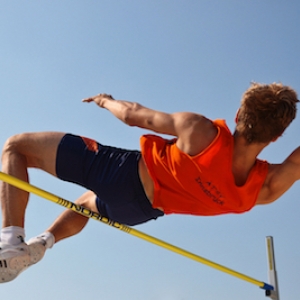How High Can You Jump?

The high jump is a sport that consists of several stages, all of which need to be completed with optimum efficiency to clear the bar in style. Before starting, athletes should ensure that they have the best track uniforms and footwear for comfort and performance. Likewise, the bar and safety mat need to be in great condition too. Nonetheless, practice makes perfect. Try incorporating these tips into your training routines, and you’ll be jumping higher than ever in no time.
Improving the Approach
Before worrying about the jump itself, gaining maximum speed and momentum down the track is vital. The approach run consists of five steps on the straight followed by five on the bend. Here’s a simple guide to perfecting yours.
- Practice the push, using long jump techniques, to stand earlier.
- Run the five-step straight without the bend.
- Run the three-point line of a basketball court to learn the curve.
- Practice straight running that ends with two to three circles to learn the transition.
- Run in circles that end with popping up into a pit.
The Takeoff
The takeoff is central to any jumping event, and the high jump is no different. Completing the transition from the curved part of the approach to a vertical takeoff will dictate the power and elevation of the jump. Mastering this part is largely about full foot contacts, with no heel recoveries, on the final two steps before takeoff.
Therefore, this should be the focus of your attention. Here’s how to increase your success.
Walk in jumps
Take steps back from the takeoff spot to essentially complete the approach in reverse. Then walk the straight before running the bend to then focus on the jump.
Approach and scissor kicks
Run the approach but then use a scissor kick to clear a lower bar instead of using the Fosbury Flop. This is all about getting that strong push off for great elevation.
Bar Clearance
Perfecting the arching motion of the Fosbury Flop isn’t easy, and it’s also quite tough to separate this from the other aspects of the jump. However, breaking it down with two simple drills should allow you to see noticeable improvements.
Back arch
From in the pit, get into the back arch. The try to push off and get the hands to touch the feet before landing into the pit.
Standing bar clearance
Stand with the back to the bar and focus on a two-footed jump before arching the back to clear the bar. After mastering this, then move onto walks, jogs, and finally sprints.
On a separate note, you’ll want to focus on your head position and movement throughout the bar clearance for improved aerodynamics.
In the Gym
While all of the above points are focused on enhancing the technique of your jump, it’s important to build the right muscles too. Therefore, a little time in the gym will boost your performance greatly. Aside from overall fitness, you should place extra attention on the following;
Calves
Need to be strong due to the hopping on toes. Skipping and tuck jumps are two fantastic exercises for strengthening this area.
Hamstrings
Needed for the explosive takeoff, especially through the extension. Focus on squats and lunges for increased power.
Hip Flexors
Needed for the approach and the bar clearance parts of the jump. Lying leg raises are a simple yet effective exercise.
Quadriceps
Needed to maximize power through the extensions. Like the hamstrings, quads will benefit from squats and similar exercises.
The Final Word
Strengthen your legs in the gym while breaking the technique into three parts with specific routines, and your jump heights will soon increase.
Looking for Custom Track and Field Uniforms or Custom Track Singlets?

